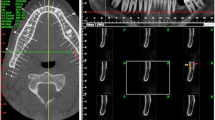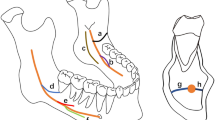Abstract
Lack of knowledge concerning the inferior alveolar canal anatomical variations had proven to increase the incidence of surgical complications, so the study aimed to assess the configuration and prevalence of bifid and trifid mandibular canals using cone beam CT in Egyptian subpopulation. Cone beam CT scans of 278 patients (530 hemi-mandibles) were included in the study, in which bifid and trifid mandibular canals or any other branching patterns were recorded and evaluated. Bifid canals were categorized following Naitoh classification, and the diameter of the main mandibular and accessory canals was measured. Bifid canals were detected in 181 canals (34%) while trifid canals in 46 canals (8.7%). Upon classifying the bifid canals, 78 canals showed forward type, 40 retromolar type, 33 dental type, and 7 canals showed buccolingual type. Two special bifid canals subtypes were reported in 23 canals and nine distinct patterns of trifid canals were reported in our study. In addition, unusual patterns of canal branching were reported in 5 cases. The mean diameter of the accessory canals was 1.18 ± .54 mm and the main canal was 3.98 ± 1.31 mm. This study reported a high prevalence (54%) of canal branching, which reinforces the importance of cone beam CT in pre-surgical planning.






Similar content being viewed by others
Availability of data and materials
Not applicable.
Code availability
Not applicable.
References
Wamasing P, Deepho C, Watanabe H, Hayashi Y, Sakamoto J, Kurabayashi T. Imaging the bifid mandibular canal using high resolution MRI. Dentomaxillofac Radiol. 2019;48(3):20180305.
Lee SK, Kim YS, Oh HS, Yang KH, Kim EC, Chi JG. Prenatal development of the human mandible. Anat Rec. 2001;263(3):314–25.
Chávez-Lomeli M, Mansilla Lory J, Pompa J, Kjaer I. The human mandibular canal arises from three separate canals innervating different tooth groups. J Dent Res. 1996;75(8):1540–4.
Juodzbalys G, Wang H-L, Sabalys G. Injury of the inferior alveolar nerve during implant placement: a literature review. J Oral Maxillofac Res. 2011;2(1): e1.
Linares C, Mohindra A, Evans M. Haemorrhage following coronectomy of an impacted third molar associated with a bifid mandibular canal: a case report and review of the literature. Oral Surg. 2016;9:248–51. https://doi.org/10.1111/ors.12206.
Malamed SF. Handbook of local anaesthesia, chapter 14, techniques of mandibular anaesthesia. N. Delhi: Elsevier Publishers; 2007.
Kumar JS, Ganapathy D, Visalakshi R. Awareness of incidence and management of nerve injuries during implant treatment. Drug Inven Today. 2019;12(5):1032.
Auluck A, Pai KM, Shetty C. Pseudo bifid mandibular canal. Dentomaxillofac Radiol. 2005;34(6):387–8.
Muinelo-Lorenzo J, Suárez-Quintanilla J, Fernández-Alonso A, Marsillas-Rascado S, Suárez-Cunqueiro M. Descriptive study of the bifid mandibular canals and retromolar foramina: cone beam CT vs panoramic radiography. Dentomaxillofac Radiol. 2014;43(5):20140090.
de Castro MAA, Barra SG, Vich MOL, Abreu MHG, Mesquita RA. Mandibular canal branching assessed with cone beam computed tomography. Radiol Med (Torino). 2018;123(8):601–8.
Fu E, Peng M, Chiang CY, Tu HP, Lin YS, Shen EC. Bifid mandibular canals and the factors associated with their presence: a medical computed tomography evaluation in a Taiwanese population. Clin Oral Implants Res. 2014;25(2):e64–7.
Auluck A, Pai KM, Mupparapu M. Multiple mandibular nerve canals: radiographic observations and clinical relevance. Report of 6 cases. Quintessence Int. 2007;38(9):781–7.
Mizbah K, Gerlach N, Maal T, Bergé S, Meijer GJ. The clinical relevance of bifid and trifid mandibular canals. Oral Maxillofac Surg. 2012;16(1):147–51.
Reda R, Zanza A, Mazzoni A, Cicconetti A, Testarelli L, Di Nardo D. An update of the possible applications of magnetic resonance imaging (MRI) in dentistry: a literature review. J Imaging. 2021;7(5):75.
Rashsuren O, Choi J-W, Han W-J, Kim E-K. Assessment of bifid and trifid mandibular canals using cone-beam computed tomography. Imaging Sci Dent. 2014;44(3):229–36.
Ngeow WC, Chai WL. The clinical anatomy of accessory mandibular canal in dentistry. Clin Anat. 2020;33(8):1214–27.
Charan J, Biswas T. How to calculate sample size for different study designs in medical research? Indian J Psychol Med. 2013;35(2):121.
Field A. Discovering statistics using IBM SPSS statistics. London: Sage; 2013.
Naitoh M, Hiraiwa Y, Aimiya H, Ariji E. Observation of bifid mandibular canal using cone-beam computerized tomography. Int J Oral Maxillofac Implants. 2009;24(1):155–9.
Kuribayashi A, Watanabe H, Imaizumi A, Tantanapornkul W, Katakami K, Kurabayashi T. Bifid mandibular canals: cone beam computed tomography evaluation. Dentomaxillofac Radiol. 2010;39(4):235–9.
Lew K, Townsend G. Failure to obtain adequate anaesthesia associated with a bifid mandibular canal: a case report. Aust Dent J. 2006;51(1):86–90.
Orhan K, Aksoy S, Bilecenoglu B, Sakul BU, Paksoy CS. Evaluation of bifid mandibular canals with cone-beam computed tomography in a Turkish adult population: a retrospective study. Surg Radiol Anat. 2011;33(6):501–7.
de Oliveira-Santos C, Souza PHC, de Azambuja B-C, Stinkens L, Moyaert K, Rubira-Bullen IRF, et al. Assessment of variations of the mandibular canal through cone beam computed tomography. Clin Oral Invest. 2012;16(2):387–93.
Badry MSM, El-Badawy FM, Hamed WM. Incidence of retromolar canal in Egyptian population using CBCT: a retrospective study. Egypt J Radiol Nucl Med. 2020;51:1–8.
Yang X, Lyu C, Zou D. Bifid mandibular canals incidence and anatomical variations in the population of Shanghai area by cone beam computed tomography. J Comput Assist Tomogr. 2017;41(4):535–40.
Villaça-Carvalho MFL, Manhães LRC, de Moraes MEL, de Castro Lopes SLP. Prevalence of bifid mandibular canals by cone beam computed tomography. Oral Maxillofac Surg. 2016;20(3):289–94.
Naitoh M, Nakahara K, Suenaga Y, Gotoh K, Kondo S, Ariji E. Comparison between cone-beam and multislice computed tomography depicting mandibular neurovascular canal structures. Oral Surg Oral Med Oral Pathol Oral Radiol Endod. 2010;109(1):e25–31.
Okumuş Ö, Dumlu A. Prevalence of bifid mandibular canal according to gender, type and side. J Dent Sci. 2019;14(2):126–33.
Zhang Y-Q, Zhao Y-N, Liu D-G, Meng Y, Ma X-C. Bifid variations of the mandibular canal: cone beam computed tomography evaluation of 1000 Northern Chinese patients. Oral Surg Oral Med Oral Pathol Oral Radiol. 2018;126(5):e271–8.
Von Arx T, Hänni A, Sendi P, Buser D, Bornstein MM. Radiographic study of the mandibular retromolar canal: an anatomic structure with clinical importance. J Endod. 2011;37(12):1630–5.
Filo K, Schneider T, Kruse AL, Locher M, Grätz KW, Lübbers H-T. Frequency and anatomy of the retromolar canal-implications for the dental practice. Swiss Dent J. 2015;125(3):278–92.
de Castro MAA, Vich MOL, Abreu MHG, Mesquita RA, De Castro M, Vich M, et al. Cross-sectional study of mandibular canal branching in regions affected by dental inflammation with cone beam computed tomography. Int J Odontostomatol. 2019;13:142–9.
Kang J-H, Lee K-S, Oh M-G, Choi H-Y, Lee S-R, Oh S-H, et al. The incidence and configuration of the bifid mandibular canal in Koreans by using cone-beam computed tomography. Imaging Sci Dent. 2014;44(1):53–60.
Funding
This research did not receive any specific grant from funding agencies in the public, commercial, or not-for-profit sectors.
Author information
Authors and Affiliations
Contributions
E. E.: data collection and examination (first radiologist), data analysis, and manuscript writing. G. Y.: project development, supervision of the work, and manuscript editing. A. S.: data examination (second radiologist), manuscript editing, and supervision of the work. K. S.: data analysis, manuscript editing, and supervision of the work.
Corresponding author
Ethics declarations
Conflict of interest
The authors declare that they have no conflict of interest.
Ethics approval
Ethical approval was granted by the local Ethics Committee of University in Alexandria university (IRB NO: 00010556-IORG0008839) in view of the retrospective nature of the study and all the procedures being performed were part of the routine care.
Additional information
Publisher's Note
Springer Nature remains neutral with regard to jurisdictional claims in published maps and institutional affiliations.
All work was done in the Oral Radiology Department Faculty of Dentistry, Alexandria University, Egypt.
Rights and permissions
About this article
Cite this article
Elnadoury, E.A., Gaweesh, Y.SD., Abu El Sadat , S.M. et al. Prevalence of bifid and trifid mandibular canals with unusual patterns of nerve branching using cone beam computed tomography. Odontology 110, 203–211 (2022). https://doi.org/10.1007/s10266-021-00638-9
Received:
Accepted:
Published:
Issue Date:
DOI: https://doi.org/10.1007/s10266-021-00638-9




